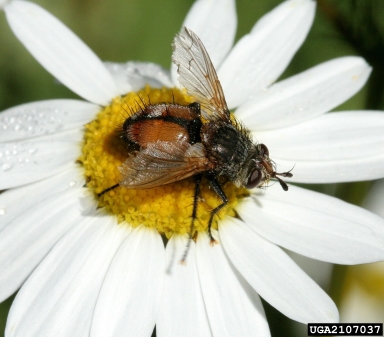
The family Tachinidae is by far the largest and most important group of insect parasitic flies, with over 1300 species in North America. All species are parasitic in the larval stage and many are important natural enemies of major pests. Many species of tachinids have been introduced into North America from their native lands to suppress populations of alien pests. Tachinid flies differ in color, size, and shape but many somewhat resemble house flies. They usually are either gray, black, or striped and often have many distinct abdominal bristles. Adults feed on liquids such as nectar and the honeydew of aphids and scale insects.

Adult flies can be found in almost all habitats resting on foliage, feeding at flowers or searching for hosts. Tachinid flies are rarely noticed by the average gardener and their beneficial activities are often overlooked (although those involved in butterfly gardening may not appreciate them).
Most tachinids attack caterpillars and adult and larval beetles. Other species kill sawfly larvae, various types of true bugs, grasshoppers, or other types of insects. There are many important pests of garden plants and forests in the Midwest that are suppressed by tachinids.
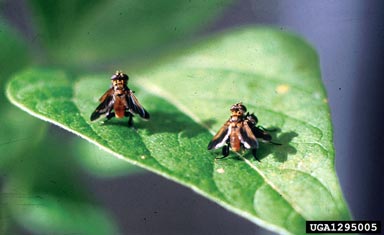
Egg laying varies considerably. In some species, eggs are deposited on foliage near the host insect. After the eggs hatch, the maggots are ingested during feeding by the host, such as a caterpillar, and then develop inside the host. In other species, the adult fly glues her eggs to the body of the host. Conspicuous white eggs up to 1 mm in size can sometimes be seen on the head or body of a caterpillar or other host. After the eggs hatch, the maggots penetrate into the host’s body.
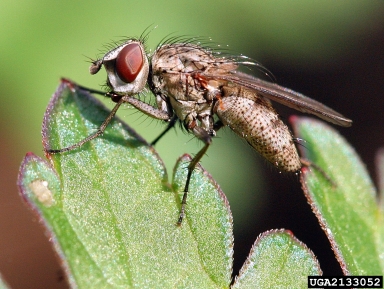
Some adult female tachinids possess a piercing ovipositor and actually insert the eggs inside the host body.
Many tachinids exhibit an unusual trait in that the eggs mature within the mother fly, which then lays eggs that immediately hatch. In some species, egg hatching actually occurs within the mother fly and she gives birth to living young.
Egg and larval development are rapid for most tachinids, and pupation often occurs within 4-14 days after egg laying. Tachinid larvae do not kill their hosts immediately but feed first on non-essential tissues, growing within the host, which continues to live normally.
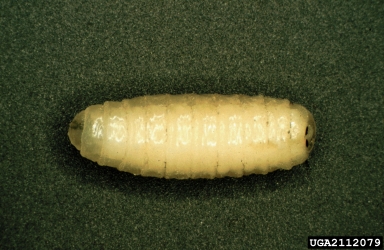
Later the growing larvae feed on essential tissue and kill the host. The pupal period generally lasts 1-2 weeks. Many species are capable of several generations per year but others are restricted to only one generation, especially if their hosts have only a single generation. Most, if not all, tachinids are internal parasites within their hosts. Most species are solitary but some are gregarious, with anywhere from 2-3 up to a dozen or more capable of developing within a single host.
Tachinids are very important in natural control of many pests, and many have been introduced and successfully established in biological control programs. The following tachinid flies, and many others not mentioned, can be important in natural control in the Midwest.
Voria ruralis
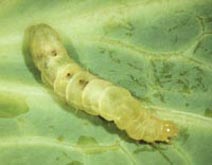
This species attacks the cabbage looper caterpillar. The female fly lays eggs on a caterpillar and one or more maggots develop within the host.
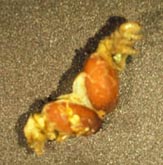
Death does not occur until the caterpillar is fully grown, so the parasite reduces neither the feeding period nor the damage. Parasitism of the cabbage looper by this
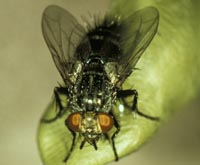
fly is variable, ranging from nothing to 45%, and does not provide effective control of cabbage looper on commercially grown vegetables.
Lydella thompsoni
This European fly is a parasite of the European corn borer. It was introduced several times into the United States between 1920 and 1940 and again in the 1980’s. USDA surveys indicate it is well established from Connecticut west to central Ohio and south into South Carolina; efforts continue to establish it in additional areas. This fly can parasitize up to 75% of corn borer larvae.
Myiopharus doryphorae
This bristly grey and black parasite of Colorado potato beetle produces live larvae, which the females insert into 2nd, 3rd, or 4th instar larvae. The maggots complete their development inside the larvae after the beetles enter the soil to pupate. Although parasitism can be high (up to 75% of the beetle population), it is usually late in the season after the potato crop has already been damaged.
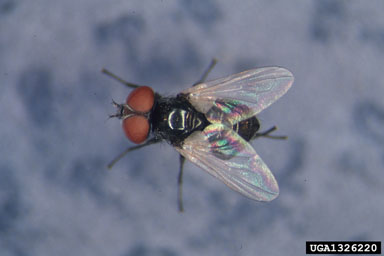
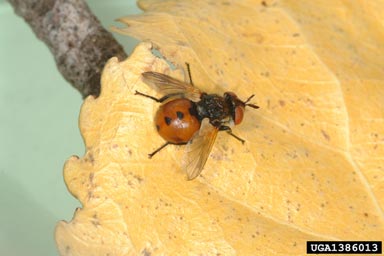
– Susan Mahr, University of Wisconsin-Madison
February, 2025





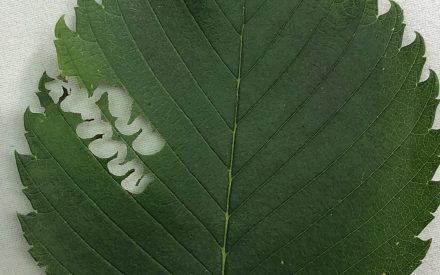 Elm Zigzag Sawfly
Elm Zigzag Sawfly ▶ Watch: How do Pesticides Affect Pollinators and Songbirds in Your Yard
▶ Watch: How do Pesticides Affect Pollinators and Songbirds in Your Yard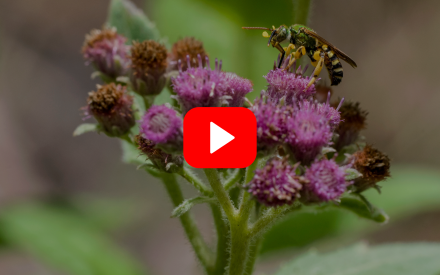 ▶ Watch: Pollinator Gardens: Plant Selection and Garden Care
▶ Watch: Pollinator Gardens: Plant Selection and Garden Care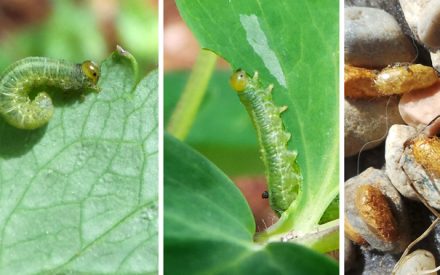 Strategies for Identifying and Managing Insect Pests
Strategies for Identifying and Managing Insect Pests


